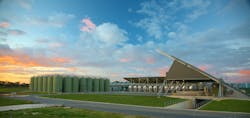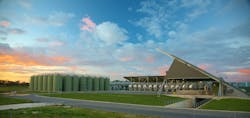Integrated Automation Framework Helps Produce Consistent Quality Wines
Making wine has always required a mixture of art and science. While the characteristics of the grapes can vary greatly from year to year with seasonal changes in temperature, rainfall, and other environmental factors, consumers today expect bottle-to-bottle consistency. Achieving that requires superior technical control over every aspect of the winemaking process, from cultivation and fermentation to blending and bottling.
One of the most advanced process control systems in the industry can be found at the Oxford Landing Estate Winery on the northern edge of Australia’s Barossa Valley. The operation is part of Yalumba, Australia’s oldest family-owned winery and one of the country’s largest wine exporters.
With 650 acres under vine, Oxford Landing’s winemakers micro-manage them as separate ecosystems in 130 five-acre blocks, enabling each block of grapes to be given exactly what it needs to achieve optimum flavor. Techniques such as detailed pruning, canopy management and crop thinning provide the winery with ultimate control in expressing the individuality of each block.
That level of control continues through harvesting and processing. The block system enables Oxford Landing to harvest small batches of the fruit as soon as they ripen. This timing is particularly crucial since the grapes need to be processed within a critical window of time where the acid and sugar content are at a premium.
According to John Ide, winery operations manager at Yalumba, “The aim for the Oxford Landing winery was an environmentally friendly plant incorporating the latest in winemaking technology, plus a new and unique process stream methodology. The objective was to achieve greater management of the process and the product.”
A sophisticated automation and control system provided by Rockwell Automation has enabled the winery to achieve a continuous production flow and the capacity to process 40,000 tons per hour. The system controls the numerous process streams, while allowing the winemakers to exert their influence and apply their experience to achieve the desired result.
The primary user interface for the system is a virtualized server supported by two virtualized clients and six onsite clients, each running FactoryTalk View SE. Winemakers and operators use this supervisory-level HMI to specify process streams, crushing speeds and fermentation schedules, as well as monitor the operational status of the entire plant.
Other components in the process automation system, which are connected by an EtherNet/IP network, include ControlLogix programmable automation controllers (PACs), which provide sequential, process, and drives control, as well as controlling refrigeration temperatures at all stages in the process; PowerFlex 700 drives control screw feeders, compressors, crushers, pumps, presses and agitators, as well as the dosing of yeasts for fermentation; PanelView HMIs; FactoryTalk EnergyMatrix to monitor energy use site-wide; and FactoryTalk ViewPoint for historical trending and real-time data for decision-making and monitoring. ControlNet and DeviceNet for device-level communications are also deployed in the process.
From a programming point of view, Rockwell Automation’s Integrated Architecture provides a common development environment for all applications using the mobility and virtualization of the FactoryTalk system. This allows data tags created in one application to be immediately available to all applications across the integrated architecture system. The ability to share data tags considerably reduces software development time, with one tag database available to both SCADA and PLC programmers.
“We can see trends in real time, and we can backtrack to specific batches as required,” Ide says. “Troubleshooting is also easy. For example, we can delve right down into the drives remotely, changing programming and configuration and perform pretty much anything. That's the advantage of a fully integrated system which has a consistent look and feel across the board.”
The Oxford Landing Estate Winery was commissioned in 2005 and has been able to meet market requirements and product quality requirements since the beginning. The secret, says Ide, is the automated process streams that ensure the grapes are fermented under optimum conditions given the high-volume throughput. It is particularly critical at all times to control the fermentation rate and minimize oxidation, both of which are highly dependent on temperature.
From the moment the grape skins are broken during harvesting, it's important to move the product quickly through the crushing stage and into the controlled environments of the fermentation tanks.
Each process stream begins at one of three hopper/crusher bays, where loads of grapes are converted into “must”—a mix of juice, skin, and seeds. The must is then pumped through one of three must chillers to reduce the temperature to around 12 degrees Celsius for white and heat or cool to 25 degrees for red.
To produce white wine, the juice is extracted from the skin and seeds and clarified prior to fermentation; conversely, red wine is fermented along with the skins in the fermentation vessel. For both styles of wine, the juice is drained and kept separate from the second stream or “pressings” of extracted product through subsequent processing and storage. After wines are fermented, they are then clarified and blended into the final product before filtration and bottling.
Maintenance operators at Yalumba’s original Angaston site can keep a close watch on trends at Oxford Landing Estate using either FactoryTalk ViewPoint or the virtual clients. Operators also have a clear view across entire lines and production processes via terminals and plant-floor HMI. “Having everything on a common visualization platform was an attractive part of the package,” adds Ide. This system is integrated with Yalumba's proprietary wine management system, which is a non-commercial database of all vintages for the purpose of batch tracking for label integrity.
About the Author
Jeanne Schweder
Contributing Editor, Automation World

Leaders relevant to this article:


